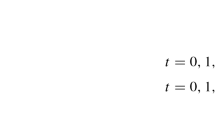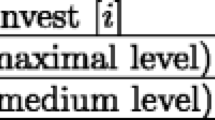Abstract
We study investment and consumption decisions in a dynamic game under learning. To that end, we present a model in which agents not only extract a resource for consumption but also invest in technology to improve the future stock. At the same time, the agents learn about the stochastic process governing the evolution of public capital, including the effect of investment in technology on future stock. Although the characterization of a dynamic game with Bayesian dynamics (and without the assumption of adaptive learning) is generally intractable, we characterize the unique symmetric Bayesian-learning recursive Cournot–Nash equilibrium for any finite horizon and for general distributions of the random variables. We also show that the limits of the equilibrium outcomes for a finite horizon exist. The addition of learning to a stochastic environment is shown to have a profound effect on the equilibrium.
Similar content being viewed by others
Notes
There is a two-way interaction between decision-making and learning. On the one hand, decision-making may have an effect on learning, which is referred as experimentation. On the other hand, the presence of learning adds risk which affects future payoffs and thus behavior.
In a different context, Mirman and To [12] have addressed the issue of investing in capital in an overlapping generation model.
See Bernhardt and Taub [3] for a recent paper on learning in oligopoly when the firms learn from prices.
There is no adaptive learning. Under adaptive learning, agents are bounded because they assume that beliefs will not change over time, i.e., they do not anticipate learning. See Evans and Honkapohja [7] for a detailed exposition of adaptive learning.
One popular approach is to rely on the fact that the family of normal distributions with an unknown mean is a conjugate family for samples from a normal distribution.
A tilde sign is used to distinguish a random variable from its realization.
Since the investment goods are perfectly substitutable, there exist many equilibrium points in which only total investment can be determined. However, for any equilibrium and for any horizon, total investment remains the same whereas individual investment changes.
References
Antoniadou E, Koulovatianos C, Mirman LJ (2013) Strategic exploitation of a common property resource under uncertainty. J Environ Econ Manag 65(1):28–39
Beck GW, Wieland V (2002) Learning and control in a changing economic environment. J Econ Dyn Control 26(9):1359–1377
Bernhardt D, Taub B (2011) Oligopoly learning dynamics. Working Paper
Bertocchi G, Spagat M (1998) Growth under uncertainty with experimentation. J Econ Dyn Control 23(2):209–231
Datta M, Mirman LJ, Schlee EE (2002) Optimal experimentation in signal-dependent decision problems. Int Econ Rev 43(2):577–607
El-Gamal MA, Sundaram RK (1993) Bayesian economists… Bayesian agents: an alternative approach to optimal learning. J Econ Dyn Control 17(3):355–383
Evans GW, Honkapohja S (2001) Learning and expectations in macroeconomics. Princeton University Press, Princeton
Freixas X (1981) Optimal growth with experimentation. J Econ Theory 24(2):296–309
Huffman GW, Kiefer NM (1994) Optimal learning in a one-sector growth model. Working Papers 90-24, Cornell University, Center for Analytic Economics
Koulovatianos C, Mirman LJ, Santugini M (2009) Optimal growth and uncertainty: learning. J Econ Theory 144(1):280–295
Levhari D, Mirman LJ (1980) The great fish war: an example using a dynamic Cournot–Nash solution. Bell J Econ 11(1):322–334
Mirman LJ, To T (2005) Strategic resource extraction, capital accumulation and overlapping generations. J Environ Econ Manag 50(2):378–386
Acknowledgements
We thank two anonymous referees for their very helpful comments.
Author information
Authors and Affiliations
Corresponding author
Rights and permissions
About this article
Cite this article
Mirman, L.J., Santugini, M. Learning and Technological Progress in Dynamic Games. Dyn Games Appl 4, 58–72 (2014). https://doi.org/10.1007/s13235-013-0089-4
Published:
Issue Date:
DOI: https://doi.org/10.1007/s13235-013-0089-4




